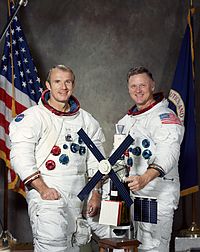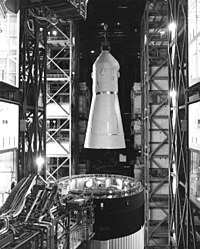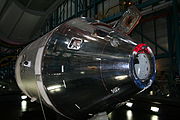Skylab Rescue
| Skylab Rescue Command Module Diagram | |
|---|---|
 | |
| Mission statistics | |
| Mission name: | SL-R Skylab Rescue Mission |
| Number of crew: | 2 launched, 5 landing |
| Launch: | On standby August 1973 - February 1974 |
| Crew picture | |
 Skylab rescue crew portrait (L-R: Vance Brand and Don Lind) | |
| Skylab Rescue crew | |
The Skylab Rescue Mission (also SL-R)[1]: iii was a backup contingency for a rescue flight to the Skylab space station.[2][3] It used a modified Command Module that was to be launched with a crew of two.[4][1]: 1–1
History
Plans for outfitting an existing Apollo Command/Service Module (CSM) into a rescue space vehicle date back to November 1970 when North American Rockwell technicians conceived the possibility of a rescue mission, as depicted in the 1969 film Marooned.[2] Marshall Space Flight Center issued a formal Mission Requirements document on 17 May 1972, with subsequent revisions.[1]: iii The standard Skylab Command Module accommodated a crew of three with storage lockers on the aft bulkhead for resupply of experiment film and other equipment, as well as the return of exposed film, data tapes and experiment samples. To convert the standard CSM to a rescue vehicle, the storage lockers were removed and replaced with two crew couches to seat five crewmen.[4]
AS 208
After Skylab 3 was launched, the crew's CSM developed a problem with two of its Reaction Control System thruster quads. They were leaking fuel, reducing the available quads to just two, the minimum for continuation of the mission.
NASA first considered bringing the crew home immediately.[3] Instead, the mission continued while the Saturn IB rocket AS 208 with CSM 119[4] was assembled in the Vertical Assembly Building at Launch Complex 39 for possible use. It was at one point rolled out to LC-39B. NASA announced on August 4, 1973 that Skylab 3 and Skylab 4 backup crewmen Vance Brand and Don Lind would fly any rescue mission. If ground personnel worked 24 hours a day and skipped some tests, the mission could launch in the first half of September,[3][5]: 299 and would last no more than five days.[1]: 2–6 The astronauts would attempt to prepare Skylab for further use, but returning experimental data and diagnosing the cause of the problem were more important.[1]: 2–1 Although Skylab had two docking ports the primary one would be used if possible, jettisoning the Skylab crew's CSM if necessary.[1]: 2–2, 3, 8
The Skylab 3 crew was able to complete its full 59 day mission on the station and safely return to earth using the two functional RCS thruster quads.[6]: 103–4
AS 209

After the Skylab 4 launch, another rescue flight was assembled as a backup contingency. The Saturn IB rocket AS 209 was assembled in the Vehicle Assembly Building at Launch Complex 39 for possible use. It also used the CSM 119 Command Module that was to be launched with Brand and Lind.
There were also plans for a short 20-day Skylab 5 flight that would use this backup CSM. The crew, consisting of Brand, Lind, and William B. Lenoir (as the Command Module Pilot), would have performed some scientific research and boosted the station into a higher orbit for use by the Space Shuttle.
AS 209 and CSM 119 were later used as a backup to the ASTP mission, and are now on display at the Kennedy Space Center's Apollo-Saturn V Center. The Saturn IB booster for AS 209 is currently located at the KSC's Rocket Garden (mated to an Apollo FVV (Facilities Verification Vehicle) formerly displayed at the VAB's Visitor Complex c. October 1968). After sitting untouched for over 30 years, the command module, in 2007, was used by NASA engineers for studies on the spacecraft's life support adapter assembly (the projecting aerodynamic fairing that allows oxygen, water, and electricity to flow from the Service Module to the Command Module), in support for the design and construction of a similar system on the new Orion spacecraft, itself resembling the Skylab Rescue configuration.
Crew
- Vance Brand — Commander
- Don Lind — Pilot
Brand flew in 1975 on Apollo-Soyuz as command module pilot, later commanding three Space Shuttle flights. Lind would wait another decade before he flew as a mission specialist on STS-51-B in 1985.
-
CSM 119 on display at the Apollo/Saturn V Center
-
SA 209 on display at the Kennedy Space Center Visitor Complex
See also
References
- ^ a b c d e f " Mission Requirements, Skylab Rescue Mission, SL-R" NASA, 24 August 1973.
- ^ a b Wade, Mark. "Skylab Rescue". Encyclopedia Astronautica. Retrieved 2009-04-10.
- ^ a b c "Skylab's New Crisis: A Rescue Mission?" TIME, 13 August 1973. Retrieved 2009-04-10.
- ^ a b c Wade, Mark. "Apollo Rescue CSM". Encyclopedia Astronautica. Retrieved 2009-04-10.
- ^ Benson, Charles Dunlap and William David Compton. Living and Working in Space: A History of Skylab. NASA publication SP-4208.
- ^ Belew, Leland. F. (editor) Skylab, Our First Space Station NASA publication SP-400.
External links
- Skylab rescue space vehicle OAT no. 1 plugs in test
- Skylab rescue space vehicle flight readiness test
- Launch vehicle test and checkout plan. - Volume 2: Saturn 1B launch vehicle Skylab R (rescue) and AS-208 flow plan and listings
- Skylab hardware evaluation CSM rescue
- Account of the mission at the Beyond Apollo Blog




